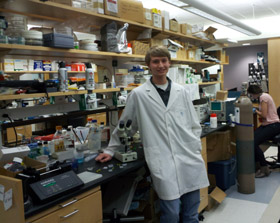Student Tackles Tissue-Engineering Challenges
-
-
slice.mit.edu
Filed Under
Recommended

When I wrote my series of articles in The Tech spotlighting the externship program and all that it has to offer, I was a reporter, synthesizing the anecdotes of others into something that people hopefully read and found interesting. I learned about one student who had spent IAP on a farm in the French countryside, and another who had received a summer internship offer from Bank of America after spending a month there as an extern.
But until I got the chance to experience it for myself, I had no idea just how fulfilling an externship could be.
I spent a month working on the coolest project ever. I was lucky enough to get an offer to extern at the Vacanti Lab, a Mass General tissue engineering lab. I was put to work on the lab’s liver project, which seeks to engineer implantable liver tissue constructs. The project has the potential to save thousands of lives.
In tissue engineering, one of the greatest challenges is blood supply. The organs in our bodies are embedded with a fine and precise array of tiny blood vessels, which usually must run within 100 micrometers of every cell to sustain life. The liver happens to have a rather intricate blood vessel architecture, which had previously been modeled by the Vacanti Lab and milled into a brass mold. My goal was to use this mold to fabricate devices that could sustain blood flow and allow for viable liver cell seeding. This would be the first step toward a tissue-engineered liver construct.
It was cool having the independence to really think critically about challenges and implement potential solutions. Tom Cervantes, my awesome sponsor and mentor, taught me lab techniques, tutored me in the CAD software SolidWorks, and showed me how to think and plan like an engineer. He mentored me at every step of the design and fabrication process.
The biggest challenge was bonding a nanoporous membrane to the device such that liver cells could interact freely with the tissue-engineered blood vessels below. As it turns out, there are a ton of different kinds of membranes. Some are completely impermeable, some permeable only to gases but not to nutrients, some are permeable to both but don’t bond well with the material of the device, and some are just so flimsy that they’ll burst with the slightest pressure. This was one of the many engineering challenges that I had to wade through during my month at the lab, and each one gave me a valuable new perspective on the liver project as a whole.
I became extremely invested in the project. I would sometimes stay at the lab until 6:00 or even 7:00, fabricating new devices or testing prototypes. At the end of the month, I presented my project to the entire lab, and heard some insightful feedback from people who had been working in the field for decades. Though it was admittedly a scary experience, it helped me recognize some of the details that I may have neglected, and allowed me to take a step back and view the project from another viewpoint.
My externship has ended, but my work is not done. I’ll be staying on as an intern during the spring term, and I look forward to making even more progress on the liver device. It’s an exciting time for tissue engineering, and I’m thrilled to be a part of it.
*Editor's note: This is part of a series of posts from MIT students and alumni who were involved in the 2012 Student/Alumni Externship Program, which connected current students to alumni in workplaces worldwide during MIT's Independent Activities Period. Alumni, learn how to get involved.






